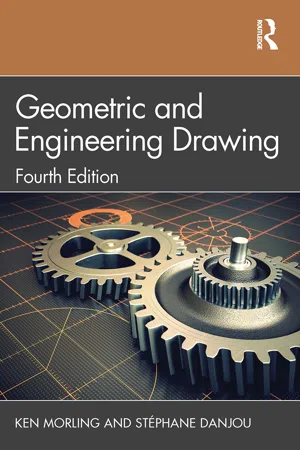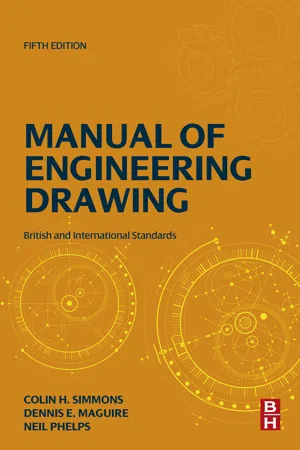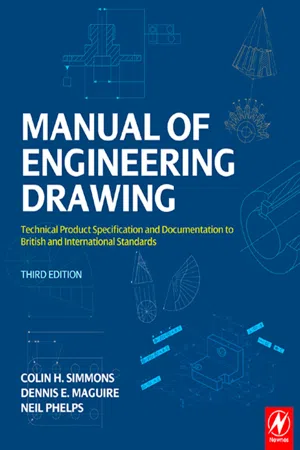Technology & Engineering
Sectional View
A sectional view is a representation of an object as if it has been sliced in half, revealing the internal features. It is commonly used in technical drawings and engineering to provide a clear understanding of an object's internal structure and components. This type of view helps to visualize complex designs and understand how different parts fit together.
Written by Perlego with AI-assistance
Related key terms
5 Key excerpts on "Sectional View"
- eBook - ePub
- Gary Thorne(Author)
- 2015(Publication Date)
- Crowood(Publisher)
pages 146–147 ). The cutting plane is often taken at centre of the object, yet any position established to cut through an object is at the discretion of the designer. The section view offers representation of internal structuring. Fundamentally an object is cut in half or through at some point: horizontally, vertically or at an inclined angle. One section is removed, and the ‘section cut’ is then rotated to give a view as a plane defining true measurements. A typical example would be a sash window unit, fireplace, or wall panel. Each of the examples has constructed layers. Through the section, relationships for interconnectivity of parts show how the whole form comes together. Even a stool may require a section view to describe further how joinery is of a constructed concern. Drawing up a rough section is often essential as a process to assist in better understanding of joinery, the fireplace and sash window being prime examples. The section view may replace one of the side views, as more relevant information may be conveyed through showing its constructed nature. Head of Construction does not require this drawing as a general rule; therefore consider how essential the additional information is when including a section view. In building geometry, plotting a section view for building a construct may well help to indicate how an object looks in three dimensions.component unit. Regular views: top view, front view, right-side view. This drawing shows the correct and incorrect manner for showing hidden lines. As the correct front view illustrates, a hidden line should preferably jump a visible line when possible.axonometric projection. Component unit.From left: orthographic projection. Component unit; top view, right-side view and elevation. Right: axonometric projection. Component unit.Layout for six views of an object. Views for construction: top view, elevation, plan, left-side view, right-side view, and rear view (shown to the left of the left-side view). Rear view required as object appears different than in other views, so too with the need to include both left and right side views. No dimensioning shown. - eBook - ePub
Manual of Engineering Drawing
Technical Product Specification and Documentation to British and International Standards
- Colin H. Simmons, Dennis E. Maguire(Authors)
- 2012(Publication Date)
- Butterworth-Heinemann(Publisher)
If the interior of a component is of an intricate nature or it contains several parts to form an assembly, then the customary orthographic drawing would contain a confusion of dotted lines, which, in addition to being difficult to draw could also be terribly difficult to understand. The reader of any engineering drawing should be able to obtain only one positive interpretation of the component, or the draughtsman has failed in his duty. Sectional drawings are prepared which cut away a portion of the component to reveal internal details, and certain standard conventions have been established to cover this aspect of drawing practice.Figure 10.5 shows some advantages of drawing a Sectional View with a small cast component.FIGURE 10.5Note, that in Plan (A), the sectional plan gives clearly the exact outline along the horizontal axis where the casting has assumed to have been cut. This contrasts with the confusion in Plan (B) which obviously results from attempting to include all the detail by inserting the appropriate dotted lines.Where the location of a single cutting plane is obvious, no indication of its position or identification is required. Figure 10.6 gives a typical example.FIGURE 10.6Half Sections
Symmetrical parts may be drawn half in section and half in outside view. This type of drawing avoids the necessity of introducing dotted lines for the holes and the recess. Dimensioning to dotted lines is not a recommended practice (Fig. 10.7 ).FIGURE 10.7Revolved Sections
A special spanner is illustrated in Fig. 10.8 . A revolved section is shown on the handle to indicate the shape of the cross-section at that point. This is a convenient convention to use on single view drawings because the shape could not be confirmed without projecting a second view or an added note.FIGURE 10.8A second type of revolved section in Fig. 10.9 - eBook - ePub
- Ken Morling, Stéphane Danjou(Authors)
- 2022(Publication Date)
- Routledge(Publisher)
Sections have already been discussed at some length in Chapter 4, where their main application was in finding the true shape across a body. When sections are used in engineering drawing, although the true shape is still found, the section is really used to show what is inside the object.A drawing must be absolutely clear when it leaves the drawing board or the CAD program. The person or persons using the drawing to make the object must have all the information that they need presented clearly and concisely so that they are not confused – even over the smallest point.Suppose that you had to draw the assembly of the three-speed gearbox on the rear hub of a pedal cycle. You probably know nothing about the interior of that hub. The reason that you know nothing about it is that you cannot see inside it. If you are to produce a drawing that can be read and understood by anybody, you can draw as many views of the outside as you wish, but your drawing will still tell nothing about the gear train inside. What is really needed is a view of the inside of the hub, and this is precisely what a section allows you to show.6.3.1 Conventions for Sections
Figure 6.10 shows two sections projected from a simple bracket. For clarity, the drawing additionally shows an isometric view of the bracket including tangent lines. You will note that the given sections are both projected from the FE. Sections can be projected from any elevation – you are not limited to the FE only. Thus, you can project a sectioned FE from either the plan or the EE. A sectioned EE is projected from the FE and a sectioned plan is projected from the FE. It is not usual to project a sectioned EE from the plan or vice versa.The lines A–A and B–B are called the sectional cutting planes, and this is a good description because, in fact, you are pretending to cut the bracket right through along these lines. Both the sectioned EEs are what you would see if you had physically cut the brackets along A–A and B–B, removed the material behind - eBook - ePub
Manual of Engineering Drawing
British and International Standards
- Colin H. Simmons, Dennis E. Maguire, Neil Phelps(Authors)
- 2020(Publication Date)
- Butterworth-Heinemann(Publisher)
10 Sections and Sectional Views Abstract A section on a drawing is used to show the detail of a component, or an assembly, on a specific plane which is known as the cutting plane. This chapter gives examples and guidance on how to specify cutting planes and present the resulting sections, including advice on the use of cross hatching. Half sections, which can be used on symmetrical parts, revolved and removed sections used to show the geometry of apart, local and successive sections used to clarify a feature or features, successive (stepped) sections where two or more parallel cutting planes are used and sectioning thin parts are shown as specific examples. Keywords Section; Views; Revolved; Removed; Microfilmed A section is used to show the detail of a component, or an assembly, on a particular plane which is known as the cutting plane. A simple bracket is shown in Fig. 10.1 and it is required to draw three Sectional Views. Assume that you had a bracket and cut it with a hacksaw along the line marked B–B. If you looked in the direction of the arrows then the end view B–B in the solution (Fig. 10.2) would face the viewer and the surface indicated by the cross hatching would be the actual metal which the saw had cut through. Alternatively had we cut along the line C–C then the plan in the solution would be the result. A rather special case exists along the plane A–A where in fact the thin web at this point has been sliced. Now if we were to cross-hatch all the surface we had cut through on this plane we would give a false impression of solidity. To provide a more realistic drawing, the web is defined by a full line and the base and perpendicular parts only have been cross-hatched. Note, that cross-hatching is never undertaken between dotted lines, hence the full line between the web and the remainder of the detail. However, the boundary at this point is theoretically a dotted line since the casting is formed in one piece and no join exists here - eBook - ePub
Manual of Engineering Drawing
Technical Product Specification and Documentation to British and International Standards
- Colin H. Simmons, Dennis E. Maguire(Authors)
- 2009(Publication Date)
- Butterworth-Heinemann(Publisher)
If the interior of a component is of an intricate nature or it contains several parts to form an assembly, then the customary orthographic drawing would contain a confusion of dotted lines, which, in addition to being difficult to draw could also be terribly difficult to understand. The reader of any engineering drawing should be able to obtain only one positive interpretation of the component, or the draughtsman has failed in his duty. Sectional drawings are prepared which cut away a portion of the component to reveal internal details and certain standard conventions have been established to cover this aspect of drawing practice.Figure 8.5 shows some advantages of drawing a Sectional View with a small cast component.Fig. 8.5
Note, that in Plan (A), the sectional plan gives clearly the exact outline along the horizontal axis where the casting has assumed to have been cut. This contrasts with the confusion in Plan (B) which obviously results from attempting to include all the detail by inserting the appropriate dotted lines.Where the location of a single cutting plane is obvious, no indication of its position or identification is required. Figure 8.6 gives a typical example.Fig. 8.6
Half sections
Symmetrical parts may be drawn half in section and half in outside view. This type of drawing avoids the necessity of introducing dotted lines for the holes and the recess. Dimensioning to dotted lines is not a recommended practice (Fig. 8.7 ).Fig. 8.7
Revolved sections
A special spanner is illustrated in Fig. 8.8 . A revolved section is shown on the handle to indicate the shape of the cross-section at that point. This is a convenient convention to use on single view drawings because the shape could not be confirmed without projecting a second view or an added note.Fig. 8.8
A second type of revolved section in Fig. 8.9 shows a case where it is required to indicate details on two separate intersecting planes. The elevation in section has been drawn assuming that the right-hand plane has been revolved to the horizontal position. Note that the thin web is not cross hatched.Fig. 8.9
Index pages curate the most relevant extracts from our library of academic textbooks. They’ve been created using an in-house natural language model (NLM), each adding context and meaning to key research topics.




